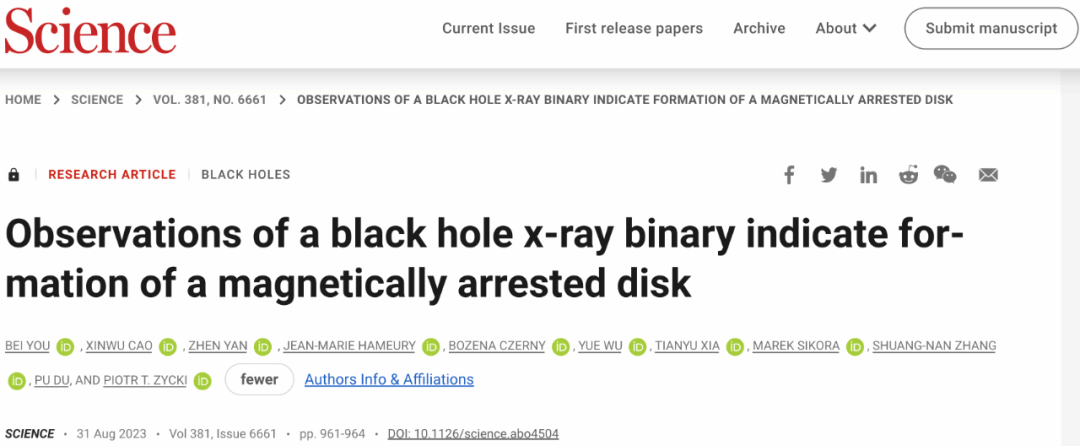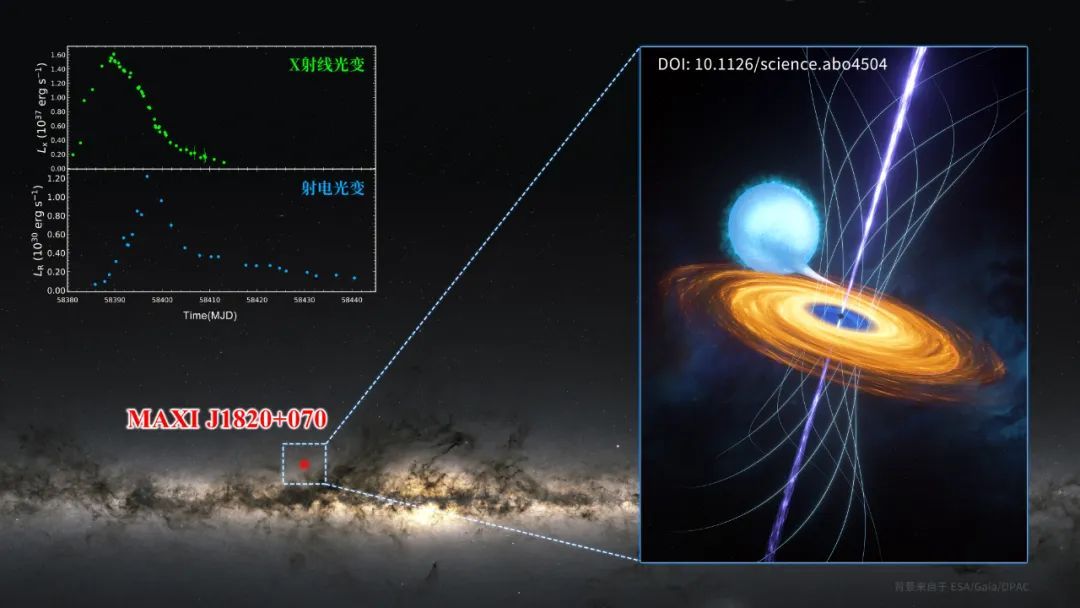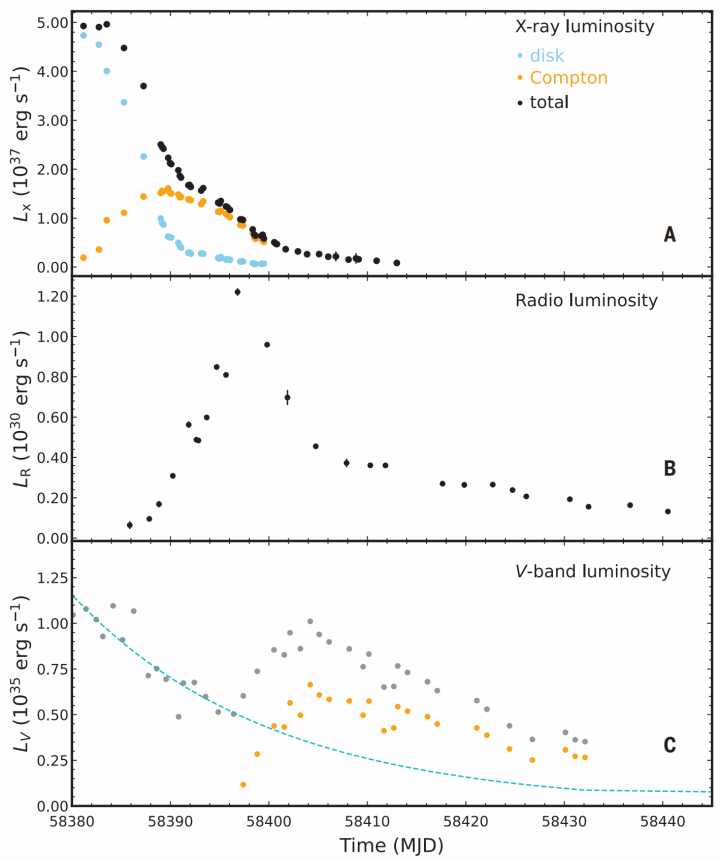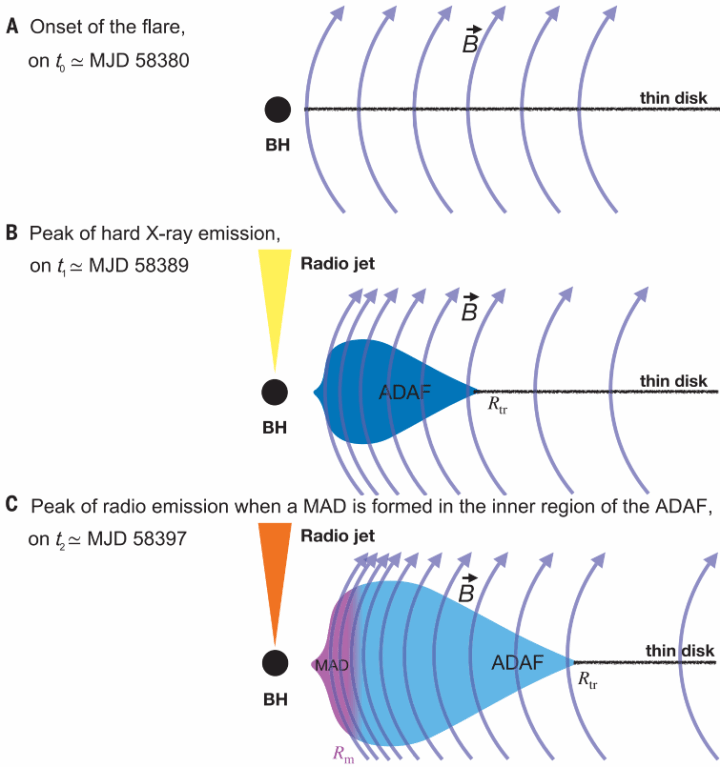On September 1, Science published an article presenting the latest research findings on black hole accreting magnetic fields conducted by an international team led by You Bei from the Department of Astronomy at Wuhan University. The title of the article is Observations of a black hole X-ray binary indicate formation of a magnetically arrested disk.

Wuhan University is the primary affiliation, and Associate Professor You Bei is the first author. Professor You Bei, Professor Cao Xinwu from Zhejiang University, and Researcher Yan Zhen from Shanghai Astronomical Observatory are the co-corresponding authors. Researcher Jean-Marie Hameury from the Strasbourg Observatory in France, Professor Bozena Czerny from the Polish Center for Theoretical Physics,undergraduate students Wu Yue and Xia Tianyu from Wuhan University's Class of 2017, Professor Marek Sikora and Professor Piotr T. Zycki from the Nicolaus Copernicus Astronomical Center of the Polish Academy of Sciences, and Researcher Zhang Shuangnan and Researcher Du Pu from the Institute of High Energy Physics of the Chinese Academy of Sciences, are co-authors.

From left to right:
Xia Tianyu (2017 undergraduate student), You Bei,
Wu Yue (2017 undergraduate student)

Figure 1: Multi-band Variability of the Black Hole X-ray Binary
MAXI J1820+070
Explanation: The red dot in the lower-left small box represents the approximate position of the black hole X-ray binary MAXI J1820+070 within the Milky Way Galaxy. The enlarged image on the right is an artistic image of the black hole X-ray binary, with a star (in blue) orbiting around the black hole. Attracted by the black hole, its material forms an arrested disk (in yellow). In the central region, a magnetically arrested disk( light blue curves represent magnetic field ) and two jets (in bright purple) from both sides are formed. The upper-left small image shows variations of the observed radio emissions of the jets and X-ray within the accretion flow over time, with an 8-day delay.
The physical process of a black hole capturing gas is referred to as "accretion", and the gas falling toward the black hole is referred to the accretion flow, which exists in a plasma state. During the viscous process of accretion flow, its gravitational potential energy can be effectively released, which is partially converted into radiation, generating multi-wavelength emissions that can be observed by ground-based and space telescopes. Therefore, through the accretion of gas, black holes indirectly reveal their presence, and the observation of this radiation has become an important approach to the study of black holes.
In 2019, the Event Horizon Telescope (EHT) collaboration unveiled the first-ever image of a black hole (M87), marking a historical moment in human history. This image peeled back the mysterious veil surrounding black holes and their surroundings . However, invisible magnetic fields are also present in the vicinity of black holes.As gas accretes onto it, the black hole also drags magnetic fields inward. According to theory, as accreted gas continuously brings in external weak magnetic fields, the magnetic field within the accretion flow gradually strengthens. Correspondingly, the external magnetic force exerted by the magnetic field on the accretion flow will also gradually increase, ultimately balancing against the inward gravitational pull of the black hole. At this point, the accreted material becomes trapped by the magnetic field and cannot freely or rapidly fall into the black hole’s event horizon, a phenomenon referred to as a "Magnetically Arrested Disk" (MAD).
The theoretical model of a magnetically arrested disk has matured significantly and has successfully explained many complex observational phenomena in black hole accretion systems. However, to date there is no direct observational evidence for the existence of a magnetically arrested disk, and the formation of such a disk remains an unsolved mystery. Several studies have suggested the possible presence of a magnetically arrested disk around the supermassive black hole at the center of the M87 galaxy. Nevertheless, even with the extremely high-resolution observations of M87 by the Event Horizon Telescope (EHT) , which provided information about the magnetic field's characteristics near the black hole, the existence of a magnetically arrested disk has not been confirmed.

Figure 2: Multi-band Variability of the Black Hole X-ray Binary
MAXI J1820+070
A (top figure) displays the variation of X-ray radiation over time, where the orange dots represent the hard X-rays from the hot accretion flow.
B (middle figure) displays the variation of radio emissions from the jet over time, with its peak lagging behind the hard X-rays by approximately eight days.
C (bottom figure) displays the variation changes in optical radiation from the outer region of the accretion disk over time. The orange dots represent the peak of optical radiation after subtracting the overall declining trend, which lags behind the hard X-rays by approximately 17 days.
In addition to supermassive black holes at the centers of galaxies, the universe also contains stellar-mass black holes. Currently, astronomers have detected the existence of stellar-mass black holes in many binary star systems, with their masses typically around ten times that of the Sun. These binary systems are mostly in a quiescent state (with extremely faint electromagnetic radiation), but occasionally, they enter a state of outburst that can last for several months or years, emitting bright X-rays. Therefore, these binary systems are often referred to as black hole X-ray binaries. Research teams have used multi-wavelength observational data, including observations from China's first X-ray astronomy satellite, the Hard X-ray Modulation Telescope (HXMT) “Huiyan”, to study the black hole X-ray binary MAXI J1820+070 during its outburst. They have observed an unprecedented long-term delay phenomenon: the radio emissions from the jet (Figure 2B) and the optical emissions from the outer region of the accretion disk (Figure 2C) lag behind the hard X-rays (Figure 2A) from the high-temperature gas (hot accretion flow) in the inner zone of the accretion flow by approximately eight days and 17 days.
The research team points out that in the outer regions of the accretion disk, weak magnetic fields are enhanced as they are carried in by the hot accretion flow around the black hole. The strengthening of the magnetic field becomes more pronounced as the radial scale of the accretion flow increases. Through the analysis of X-ray observational data, the research team discovered that hard X-ray radiation decreases as the accretion rate decreases, while the radial scale of the hot accretion flow expands rapidly as the accretion rate decreases. This rapid expansion of the accretion flow leads to a rapid increase in the magnetic field near the black hole, resulting in the formation of a magnetically arrested disk approximately eight days after the peak of hard X-ray radiation. This work represents for the first time the transport of magnetic fields within the accretion flow and the complete process of forming a magnetically arrested disk in the vicinity of a black hole. Therefore, it serves as the most direct observational evidence of the existence of magnetically arrested disks to date. Due to the universality of these physical processes, this research outcome will greatly advance our understanding of key scientific questions related to the formation of large-scale magnetic fields in accretion disks around black holes of different scales and the mechanisms behind jet acceleration.
In addition, through numerical simulations of the eruption process in black hole X-ray binaries, the research team for the first time revealed that as the accretion onto the black hole is about to terminate, more outer region accreted material accelerates its descent towards the black hole due to instability induced by the irradiation of hard X-rays. This leads to optical flares in the outer accretion flow, with the peak lagging behind the peak of hard X-ray radiation from the hot accretion flow by approximately 17 days.

A schematic diagram depicting the evolution of the accretion flow, magnetic field, and jet.
A (top figure) corresponds to the initial state of Figure 2, where the hot accretion flow (ADAF) in the inner region has not yet formed, and the magnetic field is very weak, making the jet almost undetectable.
B (middle figure) corresponds to the peak moment of hard X-rays, at which point the hot accretion flow has formed and rapidly expanded, transporting magnetic fields into the inner region, where the magnetic field becomes stronger, and the jet has been generated.
C (bottom figure) corresponds to the moment of peak radio emissions, at which the magnetic field strength in the inner region reaches the level of a magnetically arrested disk, and the radio emissions from the jet also reach their peak.
This research received support from the National Key Research and Development Program of China, the National Natural Science Foundation of China, the Fundamental Research Funds for Central Universities, the Youth Innovation Promotion Association of the Chinese Academy of Sciences, the Key Cultivation Project of the Shanghai Astronomical Observatory, the Natural Science Foundation of Hubei Province, and the Xiaomi Foundation.
The research team led by Professor You Bei has been actively involved in the exploration of astrophysical phenomena related to black holes. They conduct research on topics such as black hole accretion and relativistic jets, using a combination of multi-wavelength astronomical observations and numerical simulations.
In 2021, the research team published as study on black hole accretion in Nature Communications. The article is titled “Insight-HXMT observations of jet-like corona in a black hole X-ray binary MAXI J1820+070” (https://www.nature.com/articles/s41467-021-21169-5), with Dr. You Bei serving as the first author.
Links to papers: https://www.science.org/doi/full/10.1126/science.abo4504
Rewritten by Wang Ziyan
Edited by Li Chenxi, Sylvia, Xi Bingqing